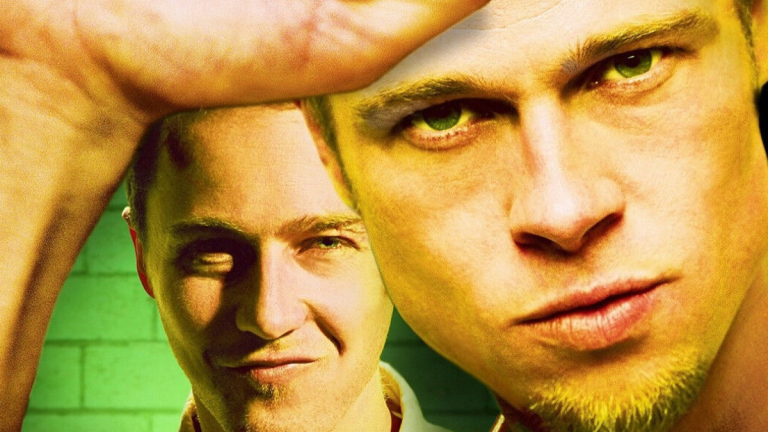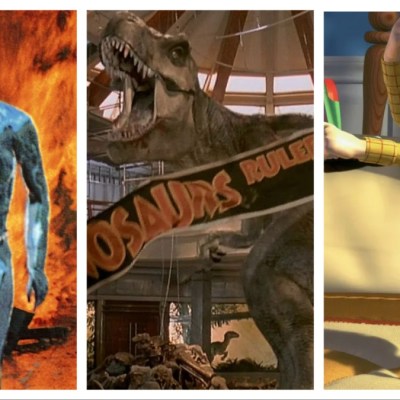The Movies That Defined Generation X
We were an angsty lot with no internet to express our teenage selves on. These are the movies that meant everything.

Gen X are a funny lot. Generally acknowledged to be made up of folks born between 1965 and 1980. This means Gen Xers were teenagers between the ’80s and the late ’90s. Crucially this also means it’s a generation that grew up without any meaningful internet and no mobile phones, who were used to relying on cinema trips to watch trailers, Blockbuster Video for our weekend viewing and highlighting the TV guide at Christmas.
Streaming services, of course, did not exist so movies we watched at the cinema, recorded off the telly and even potentially owned on VHS (if you were the Queen) became very precious in a way that something you caught on Netflix while you were looking at your phone are not. Every generation has movies that are iconic to them – here’s to the ones that shaped today’s 40-somethings+.
Before Sunrise (1995)
Richard Linklater’s naturalistic romance about a perfect night spent in Vienna between American Jesse (Ethan Hawke) and French woman Céline (Julie Delpy) after they decide to disembark the Eurorail where they met. It’s beautiful, talky and aching with wish fulfillment in an era before dating apps and email addresses. We all wanted to be Jesse or Céline.
Gen X love this, it’s our Casablanca, and it defined this generation so much that the sequels Before Sunset and Before Midnight grew up with us in the way the Toy Story movies did with Millennials. – RF
The Breakfast Club/St Elmo’s Fire (1985)
You can pretty much choose any John Hughes movie and it’ll appeal to a certain sector of Gen X. We’re picking The Breakfast Club to start, and Joel Shumacher’s St. Elmo’s Fire to follow because they have a nice continuity to them. The Breakfast Club sees five pupils on weekend detention bond over defying expectations foisted upon them by society. It’s got Molly Ringwald and Anthony Michael Hall in it, who are John Hughes regulars, but it also stars Ally Sheedy (basket case), Judd Nelson (criminal) and Emilio Estevez (jock). Then St. Elmo’s Fire also features these three in a story which focuses on older characters, a group of pals just out of college (even though both films were released in 1985). Demi Moore, Andrew McCarthy, Rob Lowe and Andie McDowell join the gang, struggling with young adulthood. It all looks terribly glamorous and grown up to youngster desperate to make a impact on the world.
See also: Pretty in Pink, 16 Candles, Some Kind of Wonderful, Say Anything and countless more. – RF
Heathers (1988)
Greetings and salutations! Michael Lehmann’s film is absolutely iconic for its four color-coordinated stars – three called Heather, and one Veronica, and for its snappy (quotable) dialogue, it’s both a satire of teenage angst and a legit exploration of it. Winona Ryder is Veronia, reluctant member of the bitchy A Group until the arrival of bad boy JD (Christian Slater) shakes things up by offing the popular kids, making it look like suicide and unwittingly giving them hidden depths they never had. It’s dark, it’s acerbic and it’s wonderful. Heather is Mean Girls before there was Mean Girls. – RF
Pump Up The Volume (1990)
A movie starring Christian Slater and Samantha Mathis about a rebel who causes uproar when he speaks the truth the grown ups don’t want to hear via his own pirate radio station, will probably look the most confusing and antiquated nonsense to Gen Z (listen kids, this is what we had before YouTube!), but in 1990 it was rad. Slater plays Mark, whose alter ego Happy Hard Hard-on exposes hypocrisies at the school he attends but after he gives a flippant response to a young man threatening suicide, Hard Harry attempts to be a voice for his generation. Inspiring and unifying for people without the internet. – RF
Dead Poets Society (1989)
‘Kid takes his own life because his dad won’t let him be in the school play’ might not have aged brilliantly but to a generation of young people (probably women let’s be honest) it was devastating and meaningful – our creativity must not be stifled! Robin Williams plays inspiring teacher John Keating who returns to the boys’ school he attended as a youth to teach English. There he finds spirited young men who he teaches to express themselves through poetry. It’s a period piece set in 1959, and is peppered with romance, tragedy and inspiration, including the well known “oh captain, my captain!” show of respect. Robert Sean Leonard and Ethan Hawke give moving performances as two of the young men, so while Peter Weir’s film may be shamelessly sentimental, Gen X was sobbing in the aisles. – RF
Reservoir Dogs (1992)/Pulp Fiction (1994)
Quentin Tarantino was SO COOL to Gen X in the early 90s, it was as if he had invented the concept of cool. These two movies with their ensemble casts, killer soundtracks, ever quotable dialogue and endless style became iconic almost immediately. Reservoir Dogs still stands up as a taught crime noir, full of violence, profanity and impressive performances. Pulp Fiction, with it’s multi-stranded narratives, sprawling plot, constant movie references and stand out set pieces became even more beloved, and Tarantino became a hero. To many he’s maintained his hero status and these films have crossed generations and belong to all of us, but there was special about ‘being there at the time’ for Gen X. – RF
Clerks (1994)/Mallrats (1995)/Chasing Amy (1997)
While we all wished we could be Tarantino, we all sort of thought we maybe could be Kevin Smith. His directorial debut, Clerks, was shot on a micro budget of just $27,000, in black and white, and focused on slacker friends working retail who hang around chatting, sabotage each other, annoy customers, fall out with their girlfriends and attempt to play a hockey game on a roof. Smith was inspired by Richard Linklater’s Slacker and Clerks brought a new anarchic, but puerile flavor and introduced the world to Jay and Silent Bob.
Mallrats had a bigger budget and a starrier cast, but a similarly childish sense of humor. This time our gang of pals hang out at a mall and get into inconsequential scrapes. Chasing Amy felt like Smith growing up a little. Ben Affleck and Jason Lee star as comic book artists whose lives are upended when they meet fellow artist played by Joey Lauren Adams. The sexual politics might not sit as well today, but at least Chasing Amy was trying to talk about something meaningful. Then he made Dogma and we were no longer interested. – RF
Empire Records (1995)
A bunch of music-loving teens try to save their beloved record store workplace from being swallowed up by the corporate monster, with a ‘let’s put the show on right here!’ ending? The plot of Empire Records has all the edginess of a Hallmark Christmas movie. So why did it feel like counter-culture back in 1995? Probably because back in 1995 we were all much, much younger, and therefore much more easily persuaded of the subversive power of Liv Tyler’s bare midriff.
One of many lukewarm reviews from the time described Empire Records as a soundtrack in search of a movie. It’s a fair criticism, and one that director Allan Moyle (Pump Up the Volume) would doubtless cop to. You could go one further and call it more poster than movie. That one-sheet featuring an 18-year-old Tyler fronting a gang consisting of Renée Zellweger, The Craft’s Robin Tunney, and crumpled pretty-boy slackers Johnny Whitworth, Ethan Embry and Rory Cochrane, achieved everything the film set out to – look cool, young and aspirational in a but-don’t-like-try way. The only thing that poster failed to achieve was to sell enough movie tickets to come close to breaking even. LM
Reality Bites (1994)
“Let me warn you,” said Janeane Garofalo on Letterman in 1994 about Reality Bites, “they’re going to try to market it as a Generation X story, which is like, the stupidest thing, it’s not, it’s just that the cast happens to be in their 20s and the director is in his 20s. It’s just a love triangle story, it’s just a normal small story, it’s not Generation X.”
Protest all you like, Garofolo, but in the movie Winona Ryder wears little round sunglasses and a vest without a shirt underneath, making it about as Generation X as they come. Add the fact that Ben Stiller’s directorial debut is about a young filmmaker (Ryder) attempting to document her friends’ attempts to “find their own identity without having any real role models or anything” and the case is closed. This ‘will she choose the yuppie or the slacker?’ romance is definitively of its time, as well as definitively dumb – the yuppie or the slacker? Choose Janeane Garofalo, you fool. LM
The Crow (1994)
Less a generation-defining movie than an adolescence-defining movie, Alex Proyas’ superhero revenge fantasy is lodged in the soul of anyone who saw it as a Goth-leaning teen and subsequently gave both versions of the soundtrack permanent residence in their Sony CD Walkman.
Adapted from the 1989 comic book series by James O’Barr, it’s the story of Eric Draven (I was this many years old before I typed that name and saw ‘Eric D Raven’. This story has layers), a rock musician who’s brought back from the dead by a crow to avenge the brutal attack in which he and his fiancé Shelly were murdered. It’s cartoonishly violent, nasty, simplistic and… possibly the coolest film ever made? The Goth stylings, the music, the dark romance, and all of it led by the performance of Brandon Lee, an actor who was tragically killed in an on-set accident during filming. It’s no wonder it’s considered legendary – the sequels, less so. And the 30th anniversary remake starring Bill Skarsgård? Let’s see. LM
Trainspotting (1996)
For a film about heroin, the original trailer for Danny Boyle’s Trainspotting doesn’t feature a single mention of the stuff. The adaptation of Irvine Welsh’s 1993 novel is cut to look like an energetic caper-comedy, which… isn’t really a misrepresentation. It’s a funny, vivid, colorful movie led by a bunch of magnetic actors and powered by a soundtrack that’s gone down in 1990s music history.
Trainspotting’s masterstroke was in bucking heroin movie tradition by daring to explain why someone might actually choose to use the drug. No sorrowful black-and-white social realist shots of people tragically wasting-away here; the scenes of Ewan McGregor’s Renton shooting up are highly saturated and orgasmic. That’s not to say the human degradation isn’t also on full display. Trainspotting makes heroin look both incredible and fucking terrible, skimming from Welsh’s book to remould his huge cast of characters into the shape of a functioning movie. It’s a modern classic for a reason. LM
The Lost Boys (1987)
“The one thing about living in Santa Carla I never could stomach: all the damn vampires,” so quips Grandpa at the blockbusting climax of Joel Schumacher’s horror-comedy The Lost Boys. The movie’s combination of Anne Rice-imagination, comic book pop culture, comedy, teen stars and romance (not to mention a sunny Californian backdrop) set a template that sired Buffy the Vampire Slayer and countless others.
It’s the story of brothers Michael and Sam (Jason Patric and Corey Haim), who move with their mother (Dianne Weist) to the beach town of Santa Carla after the death of their father. It’s all amusement piers and funfairs until Michael is targeted by a local biker gang whose members are pale, only come out at night, wear a lot of leather… and soon, there’s a fight on to save his humanity.
Is it Gen X? It’s about alienation, so yes, and the presence of more than a few Gen X poster boys (Kiefer Sutherland, Corey Feldman and Corey Haim…) cinches it. It’s also so beloved by Gen X that repeated attempts have been made to reboot it for TV in recent years, but to no avail. For the best? LM
Blade Runner (1982)
Blade Runner’s legend stems, at least in part, from its failure. Released in 1982 with a hacky, tacked-on ending and unenthusiastic voiceover narration, courtesy of a peeved Harrison Ford, the Ridley Scott noir received mixed critical notices and a general cold shoulder from audiences. Yet that made every ‘80s and early ‘90s kid who discovered it later feel like they’d unearthed lost treasure.
Layered with mystery upon mystery—was Deckard a replicant? And why did the blade runner’s partner know about the unicorns?—the film rewards numerous rewatches and intense speculation. And as its “workprint” cut became illegally available at comic conventions and among sci-fi aficionados, the film took on a genuine counterculture status as an underground classic for the cooler (or nerdier) Gen X kids. To this day it haunts, from Vangelis’ score to the enigma of what it means to see “the attack ships on fire off the shoulder of Orion”… DC
Basically All the horror films of the 70s and 80s
The ’80s was the video nasty era where a variety of horror movies were unavailable for a time, and therefore none more irresistible to people of a certain age – titles included Evil Dead, Driller Killer, Cannibal Holocaust and many more shockers of widely varying quality. It was also a massive franchise heyday, particularly of slashers – think Halloween, Friday the 13th, A Nightmare on Elm Street, Children of the Corn and more. This is why Gen Xers are quite often awful bores about horror from the era and reckon you can’t call yourself a true horror fan if you haven’t seen Leprechaun 5 and Invasion of the Flesh Hunters. – RF
The Karate Kid (1984)
The ‘80s saw an influx of movies featuring kids overcoming incredible odds. Across a variety of genres, we watched kids battle monsters, demigods, and aliens in a world typically devoid of notable adult supervision. By comparison, The Karate Kid’s story of a young man battling bullies feels relatively humble. Yet, it’s the movie that has outlived so many of its peers and crossed over into other generations. Why is that?
Well, it’s partially because karate was, and will forever remain, pretty awesome. There is something to be said for the adult factor in this film that is often missing from those other movies, though. In Mr. Miyagi, Daniel LaRusso found that almost mystical mentor who helped him find his strength and place in life. The Karate Kid is a classic sports underdog story and “boy gets girl” tale, but Miyagi’s guiding presence may have spoken loudest to a generation that would soon be defined by a general sense of feeling lost. – MB
Fight Club (1999)
Most generations have at least one great angst film that captures that almost unspeakable dread people of a certain age begin to feel when they look at the world. Fight Club is not just Gen X’s definitive angst film; it’s one of the most impactful generational angst films ever made. Its meditations on capitalism, image, and the Ikea furniture that keeps it all propped up may have been born from Gen X malaise, but elder millennials who were mainling Woodstock ‘99 culture are just as likely to claim it as their own. Many of its themes and ideas are resonating with young audiences today.
Now that we all – hopefully – understand that this movie is a meditation on the dangers of social isolation, self-indulgence, arrested development, and misplaced masculinity, it’s easier than ever to mock those who saw it and simply thought “We should start a fight club.” Yet, you just have to look at Fight Club through its own satirical lens to find the horror and beauty of its deepest message: everyone just wants to feel something. – MB


